ISSN ONLINE(2319-8753)PRINT(2347-6710)
ISSN ONLINE(2319-8753)PRINT(2347-6710)
| Vaishali Sahu1, Niragi Dave2 Assistant Professor, Department of Civil & Environment Engineering,ITM University, Sector 23 A, Gurgaon,India |
| Related article at Pubmed, Scholar Google |
Visit for more related articles at International Journal of Innovative Research in Science, Engineering and Technology
A modern lifestyle, alongside the advancement of technology has led to an increase in the amount and type of waste being generated, leading to a waste disposal crisis. Considerable economic as well as environmental benefits can be achieved when appropriate industrial waste management is implemented. Unsustainable trend in waste generation is a cause for concern because the generation of waste can be a symptom of environmentally inefficient use of resources. Therefore, development of new technologies to recycle and convert waste materials into reusable materials is critically important for protection of our environment and sustainable development of our society. Properly planned use of conventional materials and the industrial by-products alleviates a number of environmental problems. This paper therefore presents a comprehensive review of available literature on attempts at beneficial reuses of fly ash (FA) and ground granulated blast furnace slag (GGBS), in an effort to provide a compendium of recent and past developments, and update our current state of knowledge.
Keywords |
| Fly ash, environmental problem, ground granulated blast furnace slag. |
I. INTRODUCTION |
| Industrial ecology (IE) is a discipline that has gained traction over the past decades. It maintains that the most efficient way to achieve sustainable development is via the imitation of the natural world. To conserve and optimise natural resource consumption, a practitioner of IE would advocate that the by-product generated in a particular industrial process should be assimilated by other industrial activities. This minimises the overall material and energy consumption as well as reducing environmental impacts and economic costs. Waste management is a major challenge throughout the world for environmental protection and natural resources conservation. In the last few decades there has been rapid increase in the waste production due to the exponential growth rate of population, development of industry and technology and the growth of consumerism (Mannan and Ganapathy, 2004). Most of the waste do not find any effective use and cause a waste disposal crisis, thereby contributing to health and environmental problems (Ogawa, 2000). Traditionally materials like clay, sand, stone, gravels, cement, brick, block, tiles, distemper, paint, timber and steel are being used as major building components in construction sector. All these materials have been produced from the existing natural resources and will have intrinsic distinctiveness for damaging the environment due to their continuous exploitation. Nevertheless, during the process of manufacturing various building materials, especially decomposition of calcium carbonate, lime and cement manufacturing, high concentration of carbon monoxide, oxides of sulphur, oxides of nitrogen and suspended particulate matter are invariably emitted to the atmosphere. Exposure to such toxic gases escaping into the environment does lead to major contamination of air, water, soil, flora, fauna, aquatic life and finally influences human health and their living conditions. The cost of construction materials is increasing incrementally. In India, the cost of cement during 1995 was Rs. 1.25/kg and in 2005 the price increased three times. In case of bricks the price was Rs. 0.66 per brick in 1995 and the present rate is Rs. 1.9 per brick. Similarly, over a period of 10 years from the year 1995 the price of sand has increased four times. Also due to high transportation costs of these raw materials in a vast country like India, this problem is of serious concern. With increasing demand, environmental restrictions, it is essential to find functional substitutes for conventional building materials in the construction industry. In order to avert these problems, environmental and economic issues have stimulated interest in using alternative materials which are ecologically safe and relatively cheap. Efforts are now being increasingly made to take full advantage of the beneficial properties of the by-products of the industries. The creation of non-decaying waste materials, combined with a growing consumer population has resulted in a waste disposal crisis leading to an economic and environmental problem. These wastes that produced today will remain in the environment for hundreds, perhaps thousands of years. The magnitude of environmental problems like air, surface and ground water pollution and economic problem like landfilling maintenance cost etc. is very high for most of the wastes. This rapidly increasing waste stream remains a significant environmental issue and needs to manage in an economic and environmentally sustainable manner. Perhaps, the realization of this fact has led to series of concerted efforts aimed at beneficial re-uses in an effort to close the loop between efficient working of the plants generating the wastes and sustainable waste management. Reuse of waste materials is a topic of global concern and of great international interest. The urgent need for reuse of waste materials is driven primarily by environmental considerations attributable to the increased scarcity of natural resources and the increasing cost of landfill in most countries. This paper focuses on waste materials namely fly ash and ground granulated blast furnace slag. The origin of these waste materials, their properties and their reuse in civil engineering infrastructure like construction and road and pavement is discussed in this paper. This paper therefore presents a comprehensive review of available literature on attempts at beneficial reuses of these wastes, in an effort to provide a compendium of recent and past developments, and update our current state of knowledge. |
| In view of the importance of saving of energy and conservation of resources, efficient recycling of all these solid wastes is now a global concern requiring extensive R&D work towards exploring newer applications and maximizing use of existing technologies for a sustainable and environmentally sound management. This paper focuses on the reuse of potential by-products namely fly ash and ground granulated blast furnace slag (GGBS). |
| A. Solid waste generation and their environmental importance |
| Growth of population, increasing urbanisation, rising standards of living due to technological innovations have contributed to an increase both in the quantity and variety of solid wastes generated by industrial, mining, domestic and agricultural activities. Globally the estimated quantity of wastes generation was 12 billion tonnes in the year 2002 of which 11 billion tonnes were industrial wastes and 1.6 billion tonnes were municipal solid wastes (MSW). About 19 billion tonnes of solid wastes are expected to be generated annually by the year 2025 (Yoshizawa S. et al., 2004). Annually, Asia alone generates 4.4 billion tonnes of solid wastes and MSW comprise 790 million tones (MT) of which about 48 (6%) MT are generated in India (Yoshizawa S. et. al, 2004; CPCB report 2000). By the year 2047, MSW generation in India, is expected to reach 300 MT and land requirement for disposal of this waste would be 169.6km2 as against which only 20.2km2 were occupied in 1997 for management of 48MT (CPCB report 2000). The major industrial non-hazardous inorganic solid wastes are coal combustion residues, bauxite red mud, tailings from aluminum, iron, copper and zinc primary extraction processes. Generation of all these inorganic industrial wastes in India is estimated to be nearly 290 MT per annum (Gupta TN, 1998; Ramachandra, 2004). Already accumulated solid wastes and their increasing annual production are a major source of pollution. Due to environmental degradation, energy consumption and financial constraints, various organizations in India and abroad, apart from the regulatory frame work of United States Environmental Protection Agency (USEPA), have recommended various qualitative guidelines for generation, treatment, transport, handling, disposal and recycling of non-hazardous and hazardous wastes (MoEF, 2003; USEPA, 2003; Saxena SC, 1996; Hammitt JK, 1989). Safe management of hazardous wastes is of paramount importance. It is now a global concern, to find a socio, techno-economic, environmental friendly solution to sustain a cleaner and greener environment. The heterogeneous characteristics of the huge quantity of wastes generated lead to complexity in recycling and utilisation. The physico-chemical properties of solid wastes depend on the properties of feed raw materials, mineralogical origin, operating process and their efficiency. It is evident from the characteristics of these wastes, generated from different processes, that they have good potentials for recycling and utilization in developing various value-added building components. |
| Use of industrial wastes and by-products as an aggregate or raw material is of great practical significance for developing building material components as substitutes for the traditional materials and providing an alternative or supplementary materials to the housing industry in a cost effective manner. In order to effectively utilise all these solid wastes, effort have been made and mathematical models were also established universally and as a consequence considerable quantity of wastes is now being recycled and used to achieve environmentally sound management (Haque A, 2000). As against the Not In My Back Yard (NIMBY) Syndrome view on the inherent imbalance in the projectâÃâ¬ÃŸs cost in terms of human health and environment due to improper management of all these wastes, now, the Yes In My Back Yard (YIMBY) concept is gaining ground in most of the countries due to the benefits of newer technologies on waste recycling. |
II. WASTE MATERIAL UNDER STUDY |
| A. Ground granulated blast furnace slag (GGBS) |
| There are three types of slags namely, blast furnace slag, converter slag and electric furnace slag. The first two are produced by pig iron industries and the third is generated by the steel industry. The blast furnace slag, is categorized as group I waste and has been used in the manufacture of blended cement improving its soundness, strength, morphology, and abrasion resistance. However, group II materials, i.e. ferro-alloy industrial waste, have not been used extensively, but have great potential for recycling. All these solid wastes have been used in production of portland blast furnace slag cement, super sulphate cement, as an aggregate in high strength concrete and light weight concrete (Gupta TN, 1998, CPCB homepage, 2005). The group III materials include the tailings of iron, zinc, copper and gold ore beneficiation and have been used as fine aggregate or concrete filler material in the construction industries (Bhattacharyya JK et. al, 2004). It is estimated that annually about 11 MT of blast furnace slag is being released from steel plants (Sengupta J, 2002; BMTPC homepage, 2000). Ground Granulated Blast Furnace Slag (GGBS) is a by-product of the manufacturing of iron in a blast furnace where iron ore, limestone and coke are heated up to 1500âÃâæC.When these materials melt in the blast furnace, two products are produced – molten iron, and molten slag. The molten slag is lighter and floats on the top of the molten iron. The molten slag comprises mostly silicates and alumina from the original iron ore, combined with some oxides from the limestone. The process of granulating the slag involves cooling the molten slag through high-pressure water jets. This rapidly quenches the slag and forms granular particles generally no larger that 5mm in diameter. The rapid cooling prevents the formation of larger crystals, and the resulting granular material comprises some 95% non-crystalline calciumaluminosilicates. The granulated slag is further processed by drying and then ground to a very fine powder, which is GGBS (ground granulated blast furnace slag) cement. Grinding of the granulated slag is carried out in a rotating ball mill. |
| B. Fly ash (FA) |
| Coal Combustion Residues (CCRs) is a collective term referring to the residues such as fly ash, bottom ash, boiler slag, and other solid particles produced from coal combustion finally disposed to ash pond. Because of economic viability, thermal power plants mostly dispose the ashes collected by bag filter or electrostatic precipitator, as well as unburned carbon and residues settled at the bottom of the boiler together as slurry to the pond in which these are stored for a longer period. Coal Fly ash (FA) is a by-product of the combustion of pulverized coal in thermal power plants. It is removed by the dust collection systems from the exhaust gases of fossil fuel power plants as very fine, predominantly spherical glassy particles from the combustion gases before they are discharged into atmosphere. The size of particles is largely dependent on the type of dust collection equipment. Diameter of fly ash particles ranges from less than 1μm– 150 μm. It is generally finer than Portland cement. The chemical composition of fly ash is determined by the types and relative amounts of incombustible material in the coal used. The major chemical constituents in fly ash are silica, alumina and oxides of calcium and iron. Because of its fineness and pozzolanic and sometimes self-cementitious nature, fly ash is widely used in cement and concrete. Fly ash because of its mineralogical composition, fine particle size and amorphous character is generally pozzolanic and in some cases also self cementitious whereas bottom ash and boiler slag are much coarser and are not pozzolanic in nature. |
| In India, thermal power plants release approximately 112 MT of CCRs as solid waste per annum and being utilised in cement, concrete, bricks, in back fill/road embankments, adhesives, wallboard, agriculture/ soil amelioration, wasteland development, wood substitutes, paint and various environmental applications (Asokan et al, 2005). In India, about 211 billion tonnes of coal reserves exist as the largest resource of energy. Though nuclear power programme is envisaged for generation of 20,000 MegaWatt (MW) energy by the year 2020, India mainly depends on the fossil fuel from coal sources. However, to achieve a sustainable development, India need to generate around 260,000MW of power by the year 2020 and as a consequence nearly 270 MT of fly ash is expected to be released. In India, presently, 35% of the CCRs is being utilized and utilization of remaining almost 65% of CCRs is a major challenge. Keeping in view of alarming situation for safe management of CCRs to achieve Environmental Sound Management, it is crucial time for maximising the use of CCRs in newer area of applications, confidence building and increase in acceptability of CCRsbased existing products among the user agencies. In order to overcome the difficulties connected with the problem, a detailed long-term environmental and economic analysis including Life Cycle Assessment studies are to be carried out on the CCRs-based technologies with an objective to maximize the use of CCRs. |
III. PROPERTIES OF GGBS AND FA |
| A. Physical properties: |
| GGBS cement is a near-white powder. It imparts a lighter, brighter color to concrete, in contrast to the stony grey of concrete made with Portland cement. Figure 1 shows the GGBS and OPC color difference. Typical physical properties of GGBS as reported by Tasong et al. (1999) are given in Table 1. |
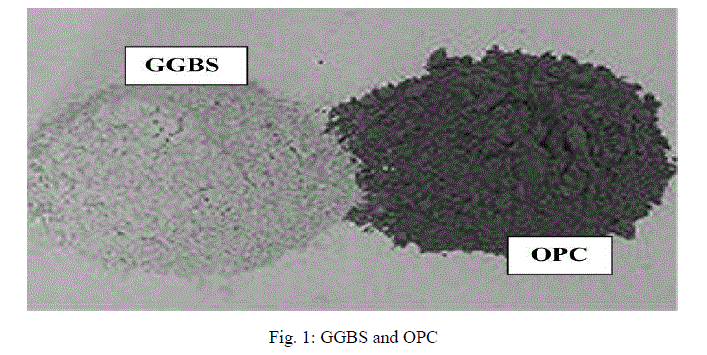 |
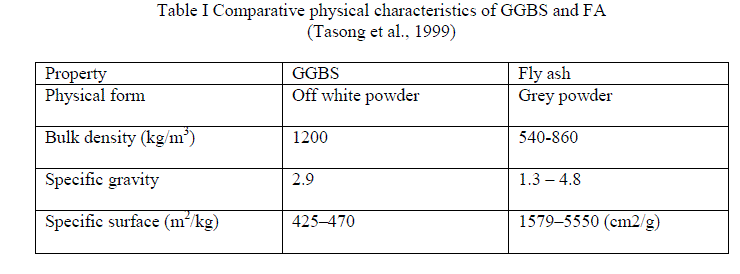 |
| B. Chemical properties |
| GGBS comprises mainly of CaO, SiO2, Al2O3 and MgO. It has the same main chemical constituents as ordinary Portland cement, but in different proportions. Typical Chemical composition of GGBS as reported by Tasong et al. (1999) is given in Table 2. |
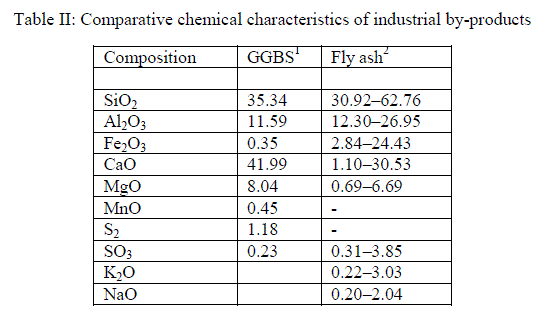 |
| The shape of GGBS processed by a vibro-mill was predominantly spherical with a smooth surface, while that by a ball mill and an airflow mill appeared to have similar edges. Generally, the fly ash particles consist of clear glassy spheres and a spongy aggregate. The SEM images of GGBS and fly ash is shown in the figure. |
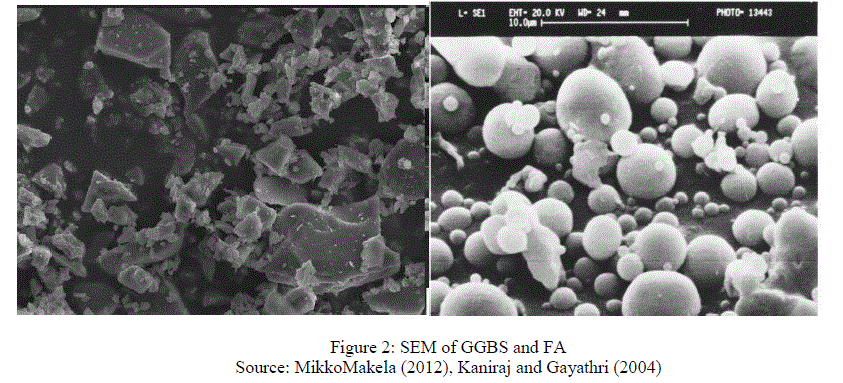 |
IV. SOLID WASTE MINIMIZATION AND SAFE MANAGEMENT OPTIONS |
| The optimal solution for solid waste management is to minimize the quantity of waste both at generation and disposal stage followed by preventive environmental management action. Recycling of solid wastes is another major productive area in which considerable quantity can be utilised for manufacturing new products. The enforcement of the Resource Conservation and Recovery Acts (RCRA) of US is one of several interacting mechanism for controlling damages from hazardous wastes (Hammitt JK, 1989). As per USEPA the hazardous wastes are defined as the wastes, which possess the characteristics of ignitability, reactivity, corrosivity, and toxicity (Saksena SC, 1996; Hammitt JK, 1989). As per the guidelines of Hazardous and Solid Wastes Amendment (HSWA), several wastes have been prohibited for land disposal. The work done both in India and abroad showed various environmental threats due to disposal of these wastes without minimising/detoxifying the contaminants. Very little work has been reported on the beneficial aspects of hazardous waste especially in ceramic products. Some of the wastes are indeed resources and raw materials and can be used in another industry. However, opportunities for this approach may be limited as a result of mismatches between waste stream composition and process specifications. These approaches can be justified because of savings in raw materials and energy inputs, as well as reductions in the costs of disposal. |
V. SAVING ENERGY, ECONOMY AND SOCIAL |
| Pollution abatement, saving energy and social benefits are the primary indices to measure the advantages in Sustainable Solid Waste Management (SSWM) System. In SSWM cost benefits analysis become a widely accepted concept for economic appraisal for designing regulatory frame work/ policy options. Presently, in India, about 28% of the total energy resources are accounted for the development of various building materials. With regard to saving energy, it is reported that for production of alumina requires about 200–250MJ/kg of energy. Similarly the manufacturing of the stainless steel and copper requires 100 MJ/kg each; cement consumes 5–8MJ/kg, clay bricks and tiles require 2–7 MJ/kg of energy. Incorporating 25% of fly ash or 40% blast furnace slag in portland-pozzolana cement saves 30% energy and results in the product of equivalent quality to that of original portland cement. Further in making burnt clay bricks, addition of 25% fly ash with clay soil could save 15% energy (Gupta TN, 2004). Cement/resin bounded board and particleboard could be used as substitute for timber. Similarly 20% of energy could be saved by introducing rice husk or groundnut for manufacturing particle board. In case of using agro-industrial wastes in various building materials as substitute for asbestos fibre, timber and mica significant amount of energy can be saved (BMTPC homepage 2005; Gupta TN, 2004). However, often mining spoils are land-tipped near the mine and simply allowed to accumulate. Straw stubble is burnt in the fields, and animal manure is stored on the farm. These wastes are having good potentials for developing other products as well as for energy generation. Stringent regulatory guidelines increase the costs of waste disposal in many industrial countries. Accurate information on the amounts and types of wastes exported, their origin and destination is not widely available. Considering the characteristics of wastes and environmental danger, multidisciplinary research work is very essential in an integrated manner to assess and understand the potential applications of hazardous and non-hazardous wastes to realise their value for various applications in an environmental friendly manner. The Basel Convention provides a framework for the control and movement of hazardous wastes with a view to achieve an environmentally sound management. |
VI. USE OF GGBS AND FA IN BUILDING AND CONSTRUCTION MATERIAL |
| These wastes have also been preliminarily studied and used as building and construction materials. However, despite the obvious advantages and increasing researches into the incorporation of industrial by-products in building and construction materials, they are yet to be fully accepted in the industry. Some of the efforts made so far at incorporating them as building and construction materials are highlighted below: |
| A. GGBS in concrete |
| Ground Granulated Blast-furnace Slag (GGBS) is a green mineral admixture that improves the rheology of fresh concrete, and its ultimate mechanical and durability properties (SusantoTeng, 2013). Presently, GGBFS has been widely used in cement based materials production around the world for a vitreous structure and exhibits cementitious properties (Lizarazo-Marriaga et al., 2011; Martinez-Aguilar et al., 2010). The concrete containing GGBFS usually has retarded setting times, lower early-ages strength, but shows higher later strength, and better durability compared with the Portland cement concrete (Binici et al., 2009; Pal et al, 2003). Additionally steel slag has cementitious properties and has the potential to be recycled and utilized in cement based materials, however, the early activity of steel slag is lower (Wang et.al., 2011). The potential cementitious properties of granulated blast furnace slag can be effectively activated by using alkaline activators (Pudon 1940; Gluhovsky et al., 1980; Shi 1996). Researches have confirmed that clinkerless alkali-activated blast furnace slag cements can exhibit higher strengths, denser structure, and better durability than Portland cement (Talling and Bradstetr 1989; Krivenko 1994; Shi and Stegemann 2000). |
| GGBS can be effectively used in concrete to reduce the pore sizes and cumulative (Basheer et al., 2002). It appears that higher GGBS replacement percentage has denser structure and prevents concrete from water penetration. The GGBS reacts with water in alkali environment and then with calcium hydroxide to form cement hydration product through pozzolanic reaction to form extra C–S–H gel in the paste and slow down the strength development at early age. Denser microstructure or lower porosity results from higher C–S–H content that represents higher GGBFS replacement percentage and higher durability of concrete. Cengiz Duran Atis (2007) studied the compressive strength of GGBS concrete under dry and wet curing conditions. It was found that the compressive strength of GGBS concrete cured at 65%RH was, at average, 15% lower than that of GGBS concrete cured at 100%RH. The increase in the watercementitious materials ratios makes the concrete more sensitive to dry curing condition. The influence of dry curing conditions on GGBS concrete was marked as the replacement ratio of GGBS increased. Qingtao Li et. al (2012) studied the effect of elevated temperature on properties of concrete containing GGBS with replacement ratios of 10%, 30% and 50% by weight of cement. The compressive strength of concrete at all percentage of cement replacement significantly decreased after exposed to elevated temperature. Above 400oC, the relative strength of concrete with 50% replacement of cement by GGBS was obviously reduced with decreases in percentage of GGBS. SusantoTenget. al (2013) used ultrafine GGBS (UFGGBS) that has increased surface area which increases the apparent rate of hydration, pozzolanic reactions and has a better filling effect. Concrete with 30% cementitious material replacement with UFGGBS was studied. They found that concrete with UFGGBS has a higher early strength, lower permeability and improved durability even at 3 days of curing. |
| B. Fly Ash |
| 1. Fly ash in concrete: |
| Coal fly ash can be utilized as high volume utilization of fly ash, medium volume uses and low volume uses. The utilization in these areas is shown in table 3. |
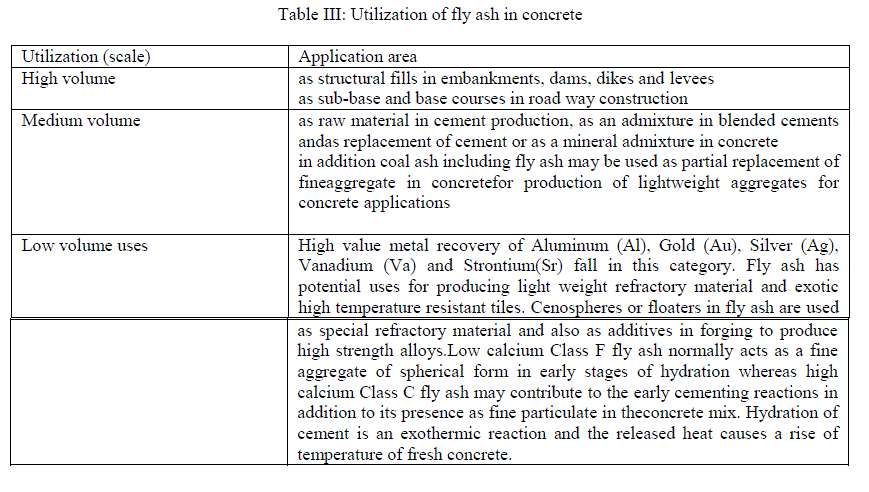 |
| 2. Fly ash as Geotechnical: |
| Studies concerning fly ash and lime utilization for soil stabilization have been conducted in the past years by many investigators like Mitchell and Katti (1981), Maher et al (1993), Consoli et al (2001). The physical and chemical mechanisms of both short and long term reactions involved in lime stabilization of the soils or soil fly ash mixtures have been extensively described in literature by Ingles and Metcalf (1972), Brown (1996). Edilet al (2006) indicated the effectiveness of fly ashes for stabilization of fine grained soils. The strength and performance of the lime-stabilized fly ash are related to the amount of lime that participates in pozzolanic reactions. The strength and durability of lime stabilized fly ash will be generally high at higher lime contents (Gray and Lin 1972; Ghosh and Subbarao 2001). Lime leachability from fly ashes was studied by Moghal and Moghal (2012) and they reported that it is due to their sustained leaching under the prevailing hydrological field conditions and their continuous exposure to fresh water. The addition of gypsum along with lime is found to increase the strength of fly ashes at any lime content and reduce the lime leachability, hydraulic conductivity and compressibility characteristics. The leaching of trace elements from fly ashes is also minimized to a great extent up on the addition of lime and gypsum to both the fly ashes. All the above mentioned factors favor their sustainable use in various geotechnical and geo-environmental applications. |
| The successful use of coal fly ash to improve the strength characteristics of soils for road construction projects was demonstrated by Trzebiatowskiet al., 2004; Simpson and Zimmie, 2009, reinforced further research to utilize fly ash in stabilizing tropical lateritic soil in other applications such as hydraulic barriers. The assessment of fly ash as a strength improvement admixture to lateritic soil relevant to the design and construction of liners and covers in waste landfills was carried out by Amadi et al. (2012) through the use of unconfined compression test. Soil mixtures containing 0 – 15% fly ash were prepared and the 28 days unconfined compressive strength (UCS) for specimens treated with fly ash prepared at wet of optimum moisture recorded values that met or exceeded specification generally considered adequate in the construction of liners and covers in waste containment structures The results reported by Osinubi and Amadi (2003, 2006) and Amadi (2011) and Amadi et al. (2012) established the potential utilization of the superfluous industrial by-product in yet another geotechnical application and at the same time expanding the utilization of the widely distributed lateritic soil. Further tests in which additives with supplementary sources of calcium oxide such as lime, cement kiln dust (CKD), etc. could be incorporated are suggested. |
| Improved geotechnical characteristics of compacted soil-fly ash-copper slag mix and compacted soil-fly ashlime/ cement mix have been described through unconfined compressive strength (UCS), triaxial shear strength and durability tests in the literature (Consoli et al. 2001; Ghosh and Subbarao 2007; Havanagi et al. 2007; Consoli et al. 2011). Consoli et al. (2001 and 2011) investigated the influence of fly ash and lime on the shear strength characteristics of a sandy soil-fly ash-lime mixture and developed relationships between unconfined compressive strength and various controlling factors. Patel et al. (2007) studied geotechnical properties of copper slag mixed with different percentages of fly ash (20, 25, 30, 35 and 40%) and reported the maximum CBR value of 32 for a mix of 80% slag and 20% fly ash. Havanagi et al. (2007) reported the maximum angle of friction of 41° and UCS of 5698 kPa for 28 days curing period for 75% copper slag and 25% fly ash mix stabilized with 3 to 9% cement. They recommended that the mix with minimum 3% cement can be used in the base course of road pavements. |
| Shahuet. al (2012) investigated the shear strength characteristic of copper slag-fly ash-dolime mix by conducting unconfined compression tests, durability tests and unconsolidated undrained triaxial tests on compacted specimens for different curing periods. They reported the increases in (UCS) with the fly ash content up to 20% and decreases thereafter except for 0% dolime for which the maximum value of UCS occurs at 30% fly ash content while the UCS values increase rapidly with the increase in dolime content up to 15%. The rate of gain of strength with the further addition of dolime becomes negligible thereafter. UCS values increase rapidly with the increase in curing period upto first 14 days for all mixes. Based on UCS test results, 20% fly ash + 80% copper slag mix stabilized with 15% dolime i.e., 20F+80C+15D mix is recommended as the optimum mix for use in base course of flexible pavement. |
VII. CONCLUSIONS |
| During different industrial mining, agricultural and domestic activities, India produces annually about 960 MT of solid wastes as by-products, which pose major environmental and ecological problems besides occupying a large area of land for their storage/disposal. Looking to such huge quantity of wastes as minerals or resources, there is a tremendous scope for setting up secondary industries for recycling and using such solid wastes in construction materials. Though many lab processes, products and technologies have been developed based on agro-industrial wastes, non-acceptability of the alternative and newly developed products among users due to lack of awareness and confidence is to be removed. However, environment friendly, energy-efficient and cost effective alternative materials developed from solid wastes will show good market potential to cater to peopleâÃâ¬ÃŸs needs in rural and urban areas. To effectively utilise these wastes as a raw material, filler, binder and additive in developing alternative building materials, detailed physical-chemical, engineering, thermal, mineralogical and morphological properties of these wastes are to be evaluated and accurate data made available. In order to maximize the use of alternative building materials developed from different types of solid wastes and to increase the production capacity of lab scale processes, technology-enabling centres are needed to be set-up to facilitate entrepreneurs for effective commercialisation. Durability and performance of the newer products and dissemination of technologies emphasising costs-benefits analyses and life cycle assessment report will significantly contribute to successful commercialisation of innovative processes. Inclusion of industrial waste-based newer building materials, emphasizing their environmental significance in the curriculum at higher education level and practical applications of wastes in construction sector will give fillip to such technology promotion. The scientific advancement in recycling and using industrial and agricultural processes for utilizing wastes will lead to a better use of worldâÃâ¬ÃŸs resources. The new and alternative building construction materials developed using agroindustrial wastes have ample scope for introducing new building components that will reduce to an extent the costs of building materials. The endeavour, therefore, needs to be to encourage entrepreneurs and construction agencies to develop new products and processes using all these wastes as raw materials for setting up secondary industries and contributing to reduction of green house gases and global warming. |
References |
|